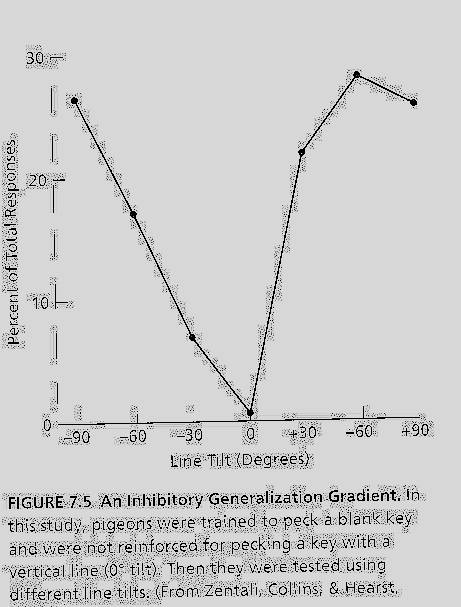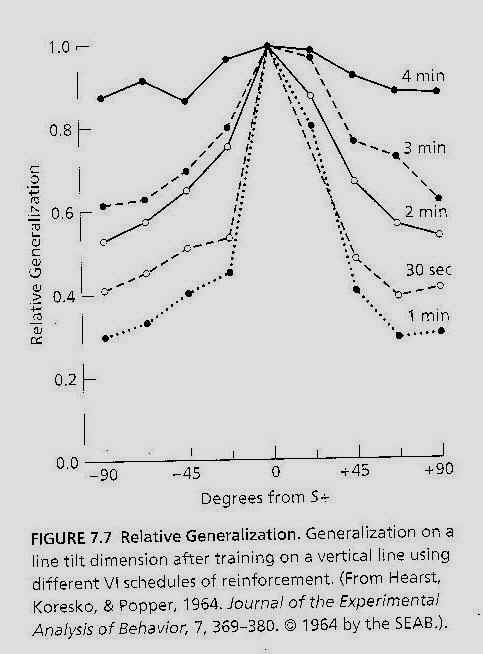
Psy
342 Learning & Memory
Ch.
7 Generalization, Discrimination, & Concepts
Classical conditioning paradigm
Instrumental/Operant conditioning paradigms
(1)
stimulus generalization tests
(2)
Probe trials
In
both paradigms, the typical finding is _________________________?
Guttman
& Kalish (1956)

The shape of the generalization gradient reflects the degree of stimulus generalization that an organism exhibits.
What
is the typical shape of a stimulus generalization gradient?

How
much generalization does a steep gradient indicate?
shallow gradient—substantial responding occurs even to stimuli that are highly DISSIMILAR to the training stimulus.
How
much generalization does a shallow gradient indicate?
What
kind of information is represented on the X-axis?
What
kind of information is represented on the Y-axis?
Absolute
gradients vs. Relative gradients
Excitatory
vs. Inhibitory gradients

B. Important Variables
1. Degree of Original Learning
Hearst
& Koresko (1968)

The more training pigeons received with the vertical-line stimulus, the greater was the level of responding to this stimulus on test trials.
Also, more training REDUCED generalization
**This effect of degree of training on absolute generalization gradients is reasonably common.
There is disagreement as to whether increased training on the original stimulus (S+) reduces generalization in a RELATIVE SENSE.
2. Motivational Level
Kalish & Haber (1964)—Before being trained to peck a colored key, pigeons were deprived of food to 70%, 80%, or 90% of their free feeding body weight.
Which
group is considered to be the most motivated?
Kalish
& Haber found that increased levels of motivation resulted in greater
responding to the S+ during the generalization test.
They
also found that higher levels of motivation tended to produce STEEPER
absolute-generalization gradients.
*Opposite
results (shallow gradients) with relative generalization gradients.
3. Schedules of Reinforcement
Hearst, Koresko, and Popper (1964)
All pigeons were exposed to a VI schedule, but the average length of the inter-reinforcement interval was 30 seconds or 1, 2, 3, or 4 minutes in the five groups, respectively.

*Schedules
of reinforcement that provide more frequent reinforcement tend to reduce
generalization.
4. Duration of Training-Test Interval
Several
studies have shown that the tendency to generalize increases as the
training-test interval is lengthened.
Thomas
& Lopez (1962) trained pigeons to peck a colored key and later tested them
using keys of different colors. Pigeons were tested 1 minute, 1 day, or 1 week
after training.

Pigeons tested after 1 minute exhibited very steep generalization gradients (little generalization). Those tested 1 day or 1 week after training showed somewhat flatter gradients.
Why is this effect often interpreted as an example of forgetting?
5. Previous Discrimination Training
Usually results in less generalization

Also, compare the wavelength at which the peak occurs for the two groups
Peak-shift phenomenon